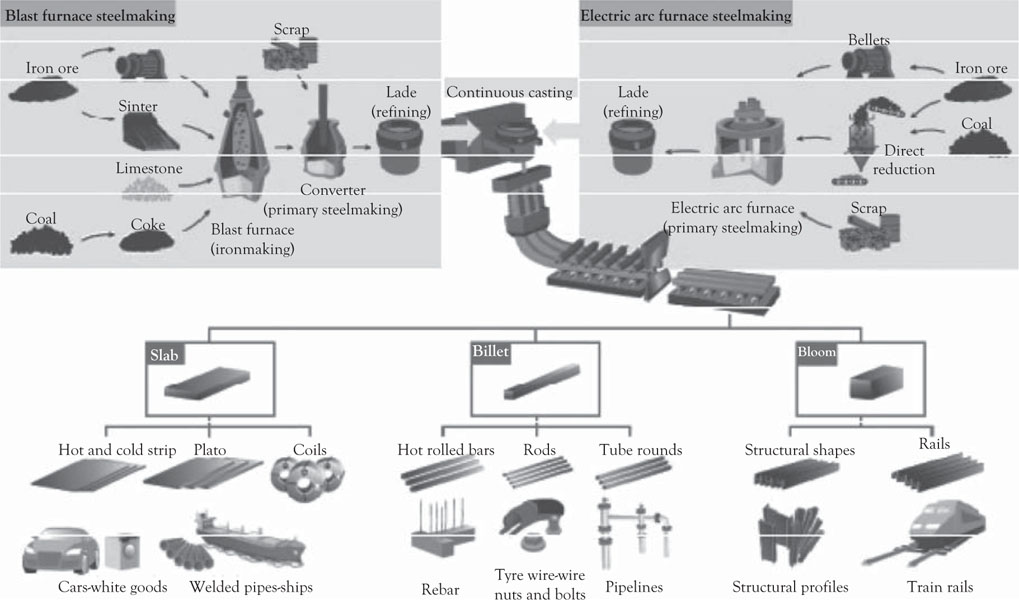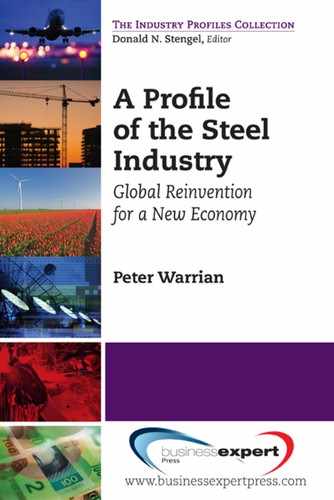Steel: The Metal and Its History
Iron is found in the Earth’s crust in the form of an ore, usually an iron oxide. Iron is extracted by smelting, removing the oxygen, and combining the ore with a preferred chemical partner such as carbon. Ancient methods of smelting have been used since the Bronze Age. The Haya people of East Africa invented a type of high-heat blast furnace, which allowed them to forge carbon steel nearly 2,000 years ago.
Steel is a metal alloy made by combining iron and another element, usually carbon, but it can also be combined with manganese, chromium, vanadium, and tungsten. When carbon is used, its content in the steel is between 0.2% and 2.1% by weight, depending on the grade. Varying the amount of alloys and their form controls qualities such as the hardness of the final product. Steel with increased carbon content can be made harder and stronger than iron, but such steel is also less ductile than iron, meaning that it is less able to be stretched into something like wire. Alloys with carbon content higher than 2.1% are known as cast iron.
The Earliest Sites of Steelmaking Were in the Middle East, East Africa, and Far East
The earliest known production of steel is a piece of ironware excavated from an archeological site in Anatolia and is about 4,000 years old. Other ancient steel comes from East Africa, dating back to 1400 BC. In the 4th century BC, steel weapons were being used by the Roman military. The Chinese of the Warring States (403–221 BC) had quench-hardened steel, while the Chinese of the Han Dynasty (202 BC–220 AD) created steel by melting together wrought iron with cast iron.
Evidence of the earliest production of high carbon steel on the Indian Subcontinent was found in Sri Lanka. Wootz steel was produced in India by about 300 BC. In Sri Lanka, this early steelmaking method employed the unique use of a wind furnace, blown by the monsoon winds capable of producing high-carbon steel. Also known as Damascus steel, Wootz is famous for its durability and ability to hold an edge. It was essentially a complicated alloy with iron as its main component. Along with their original methods of forging steel, the Chinese also adopted the production methods of creating Wootz steel, an idea imported into China from India by the 5th century AD.
In Europe, steel was produced long before the Renaissance, but it became more common after the 17th century. With the invention of the Bessemer process in the mid-19th century, steel became an inexpensive mass-produced material. Further refinements in the process, such as the basic oxygen furnace (BOF), lowered the cost of production while increasing the quality of the metal. Modern steel is generally identified by various grades defined by assorted standards organizations such as the Society of Automotive Engineers (SAE).
The modern era in steelmaking began in England with the introduction of Henry Bessemer’s process in 1858. His raw material was pig iron. This enabled steel to be produced in large quantities cheaply. The Gilchrist–Thomas process (or basic Bessemer process) was an improvement to the Bessemer process, lining the converter with a basic material to remove phosphorus.
These were rendered obsolete by the Linz–Donawitz process of basic oxygen steelmaking (BOF), developed in the 1950s. Basic oxygen steelmaking is superior to previous steelmaking methods because the oxygen pumped into the furnace limits impurities. Now, electric arc furnaces (EAFs) are a common method of reprocessing scrap metal to create new steel. They can also be used for converting pig iron into steel, but they use a lot of electricity (about 440 kWh per metric ton), and are thus generally only economical when there is a plentiful local supply of cheap electricity.
Modern steels are made with varying combinations of alloy metals. Carbon steel, composed simply of iron and carbon, accounts for 90% of steel production. High-strength, low alloy steel has small additions (usually <2% by weight) of other elements, typically 1.5% manganese, to provide additional strength for a modest price increase. Low alloy steel is combined with other elements, usually molybdenum, manganese, chromium, or nickel, in amounts of up to 10% by weight to improve the hardenability of products like beams. Stainless steels and surgical stainless steels contain a minimum of 11% chromium, often combined with nickel, to resist corrosion and rust. Some stainless steels are magnetic, while others are not.
Other more modern steels include tool steels, which are alloyed with large amounts of tungsten and cobalt or other elements to maximize hardening. This also allows the use of precipitation hardening and improves the alloy’s temperature resistance. Tool steel is generally used in axes, drills, and other devices that need a sharp, long-lasting cutting edge. Other special-purpose alloys include weathering steels, which weather by acquiring a stable, rusted surface, and so can be used unpainted.
Many other high-strength alloys exist, such as dual-phase steel, which is heat-treated to contain a microstructure that gives extra strength. This bridges the age-old problem where increased strength means increased hardness, which is what brought down the Titanic. Particularly in cold water, the ship’s steel was unusually brittle and could not absorb the impact of contact with ice.
Transformation-induced plasticity (TRIP) steel involves special alloying and heat treatments to create a very strong but still malleable metal. Twinning-induced plasticity (TWIP) steel uses a specific type of strain to increase the effectiveness of work hardening on the alloy. Others use a combination of over a dozen different elements in varying amounts to create a relatively low-cost metal for use in high-wear applications such as bulldozer blade edges and cutting blades on the Jaws of Life.
Before the introduction of the Bessemer process and other modern production techniques, steel was expensive and was only used where no cheaper alternative existed, particularly for the cutting edge of knives, razors, swords, and other items where a hard, sharp edge was needed. It was also used for springs, including those used in clocks and watches. With the advent of speedier and lower cost production methods, steel has been easier to obtain and is much cheaper. It has replaced wrought iron for many purposes.
Images and Realities of the Steel Industry
Our perceptions of the steel industry and its presentation in the media are greatly determined by images, often those of the past. Therefore, it is important to get a quick read on the stages the industry has gone through.
The images of modern steel are still very much the creature of the early 20th century. This is the industry as it was portrayed in the classic film clips of sparks, smoke, and gritty workers appearing in grainy old movies. Sweaty men move around between molten metal and huge machines. It was a kind of industrial gigantism. Huge blast furnaces made hot iron, which was converted to steel in open hearth (OH) furnaces then rolled into flat and round shapes. In old pictures, you can see huge mechanical cranes and rolling machines moving hot metal around, though this actually represented the change from steam to electric power. The electrical machinery could be controlled much more finely and continuously than the older steam-driven processes. The biggest product lines were rails for transportation and building beams for the new generation of skyscrapers, which were a steel invention. In fact, the design of skyscrapers first appearing in Chicago was an iron railway bridge turned on end.
New Deal Steel
The interwar period was characterized by a change in product lines to more consumer goods—cars, refrigerators, and stoves. These required large scale production of sheet steel. The critical technology breakthrough was the continuous wide strip mill, which could continually pass metal back and forth under the rollers to produce the required gauges. No more did steelworkers have to grab hot sheets with tongs and passed them back and forth, one by one, into the rolling machines. This was the enabling technology for mass market steel.
Postwar Steel
The steel industry grew enormously during World War II to support the war effort. Technically, it was more of the same but focused on heavy plate products for ships, tanks, and guns. By the 1950s there was a fundamental shift to ramp-up the scale and speed of production to meet the requirements of the exploding consumer economy. New Basic Oxygen Furnaces (BOFs) at the steelmaking stage and continuous casters (CCs) revolutionized the rolling process. Together, this technology combination, only really perfected by the Japanese in the mid-1960s, became the defining technology for large steel producers. However, the EAF, a small scale but highly efficient scrap steel-fed technology began, in the 1960s, to eat into the lower value-added product markets.
Global Steel
Steel went global beginning in the 1990s. A wide consolidation of steel companies was sparked by the divestment of formerly government-owned steel mills to private ownership. Some were shut, but many were consolidated into new steel conglomerates, led by what is now the largest steel company in the world, ArcelorMittal. This was accompanied by the almost entirely unexpected development of China as the dominant steel industry, which in 2012 is expected to have nearly 900 MTs of steel capacity in a global steel industry of 1,600 MTs.
How Steel Is Made
There are two fundamentally different ways to make steel—directly from raw materials or by re-melting steel scrap. However, both are fundamentally batch processes, which, as discussed later, present challenges in a world of Just-in-Time delivery and lean production manufacturing.
Integrated steel companies start with blast furnaces making hot iron from iron ore and coal. The iron is then converted into steel in a basic oxygen furnace (BOF) also called oxygen blown converter (OBC) technology. These furnaces convert raw materials (iron ore, coking coal, and limestone) into basic steel shapes.
The second steelmaking technology uses electric arc furnaces (EAFs) with large electrodes which melt scrap to produce steel, essentially a recycling process (Figure 2.1). The scrap metal is then converted to basic steel shapes.

Figure 2.1. Steel manufacturing.
Source: World Steel Association.
There are some sites that use both technologies within the same facility. Today, in the United States, 48% of the EAF capacity is actually owned by integrated steel companies.
Primary steel mills produce the basic steel shapes: slabs, billets, and blooms, which are then further processed into semifinished steel products. Slabs are converted into hot and cold strip steel, steel plate, and coiled steel sheet. Billets are further processed into various shapes of bars, rods, and tubes. Blooms are made into structural shapes for the construction industry and for rail. The conversion of basic steel shapes into semiprocessed steel products usually takes place within a primary steel mill.
The following graphic illustrates the manufacture of the three basic steel shapes and their conversion into semiprocessed products for applications in various downstream industries.
Semiprocessed steel products may be further treated to produce products such as steel pipe. However, most semiprocessed steel products are supplied to downstream manufacturers. Historically, some of these downstream manufacturers were closely linked to primary steel producers, although this is no longer typically the case.
The downstream market may be supplied either directly or indirectly. Large industries, such as the auto industry, are supplied directly by the primary steel producers. Re-bar for use in reinforcing concrete is also usually supplied directly to the construction industry by the primary producers. In North America, companies in other industries now are generally supplied through Metal Service Centers, which are independent wholesale distributors of semiprocessed steel products (and other metals). Outside of North America, metal service centers are often affiliated to primary steel-producing companies and distribute mainly or exclusively the output of their parent firm.
These segments taken together, the primary steel mills of both BOF and EAF production, the service centers and steel fabricators, constitute the Steel Sector of the modern economy.
